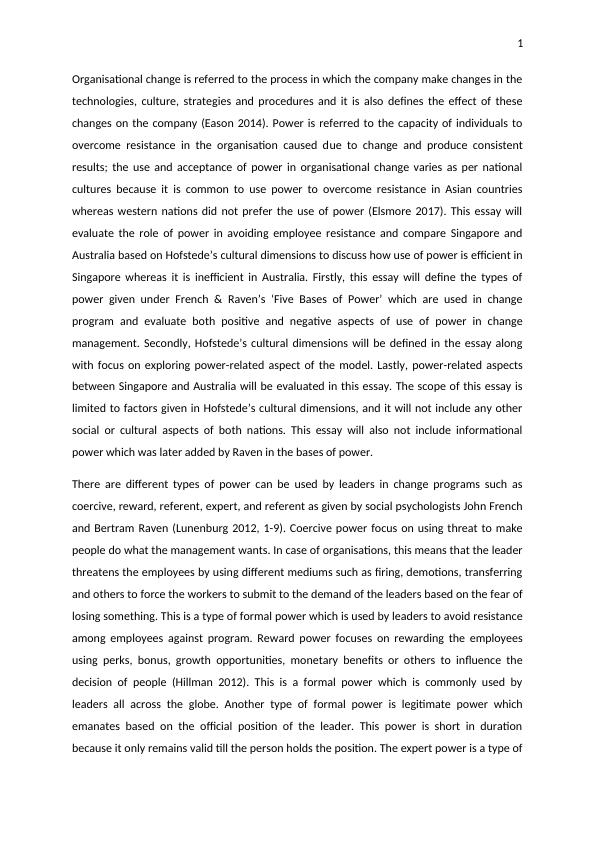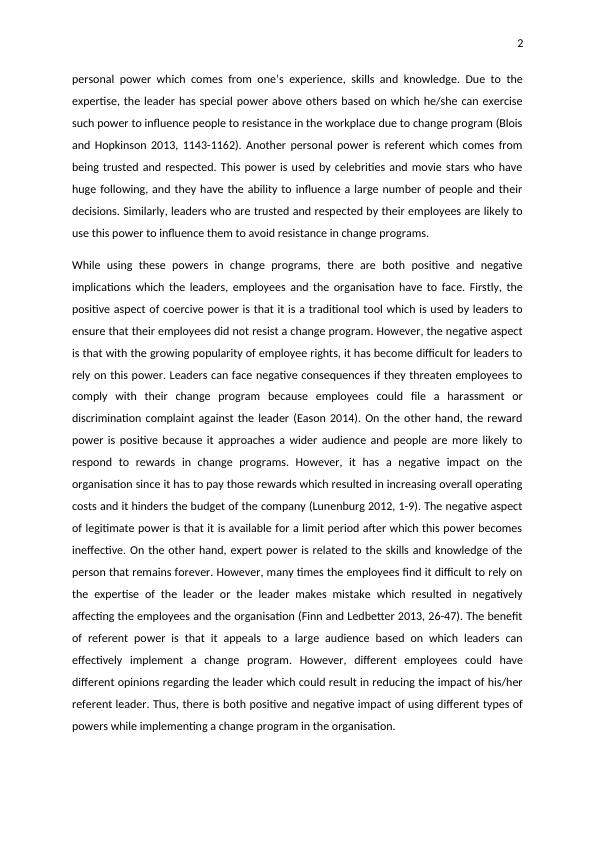The Role of Power in Organisational Change: A Comparison of Singapore and Australia Based on Hofstede's Cultural Dimensions
Added on 2023-06-03
8 Pages2730 Words259 Views
0
Organisation Development and Change
Organisation Development and Change

1
Organisational change is referred to the process in which the company make changes in the
technologies, culture, strategies and procedures and it is also defines the effect of these
changes on the company (Eason 2014). Power is referred to the capacity of individuals to
overcome resistance in the organisation caused due to change and produce consistent
results; the use and acceptance of power in organisational change varies as per national
cultures because it is common to use power to overcome resistance in Asian countries
whereas western nations did not prefer the use of power (Elsmore 2017). This essay will
evaluate the role of power in avoiding employee resistance and compare Singapore and
Australia based on Hofstede’s cultural dimensions to discuss how use of power is efficient in
Singapore whereas it is inefficient in Australia. Firstly, this essay will define the types of
power given under French & Raven’s ‘Five Bases of Power’ which are used in change
program and evaluate both positive and negative aspects of use of power in change
management. Secondly, Hofstede’s cultural dimensions will be defined in the essay along
with focus on exploring power-related aspect of the model. Lastly, power-related aspects
between Singapore and Australia will be evaluated in this essay. The scope of this essay is
limited to factors given in Hofstede’s cultural dimensions, and it will not include any other
social or cultural aspects of both nations. This essay will also not include informational
power which was later added by Raven in the bases of power.
There are different types of power can be used by leaders in change programs such as
coercive, reward, referent, expert, and referent as given by social psychologists John French
and Bertram Raven (Lunenburg 2012, 1-9). Coercive power focus on using threat to make
people do what the management wants. In case of organisations, this means that the leader
threatens the employees by using different mediums such as firing, demotions, transferring
and others to force the workers to submit to the demand of the leaders based on the fear of
losing something. This is a type of formal power which is used by leaders to avoid resistance
among employees against program. Reward power focuses on rewarding the employees
using perks, bonus, growth opportunities, monetary benefits or others to influence the
decision of people (Hillman 2012). This is a formal power which is commonly used by
leaders all across the globe. Another type of formal power is legitimate power which
emanates based on the official position of the leader. This power is short in duration
because it only remains valid till the person holds the position. The expert power is a type of
Organisational change is referred to the process in which the company make changes in the
technologies, culture, strategies and procedures and it is also defines the effect of these
changes on the company (Eason 2014). Power is referred to the capacity of individuals to
overcome resistance in the organisation caused due to change and produce consistent
results; the use and acceptance of power in organisational change varies as per national
cultures because it is common to use power to overcome resistance in Asian countries
whereas western nations did not prefer the use of power (Elsmore 2017). This essay will
evaluate the role of power in avoiding employee resistance and compare Singapore and
Australia based on Hofstede’s cultural dimensions to discuss how use of power is efficient in
Singapore whereas it is inefficient in Australia. Firstly, this essay will define the types of
power given under French & Raven’s ‘Five Bases of Power’ which are used in change
program and evaluate both positive and negative aspects of use of power in change
management. Secondly, Hofstede’s cultural dimensions will be defined in the essay along
with focus on exploring power-related aspect of the model. Lastly, power-related aspects
between Singapore and Australia will be evaluated in this essay. The scope of this essay is
limited to factors given in Hofstede’s cultural dimensions, and it will not include any other
social or cultural aspects of both nations. This essay will also not include informational
power which was later added by Raven in the bases of power.
There are different types of power can be used by leaders in change programs such as
coercive, reward, referent, expert, and referent as given by social psychologists John French
and Bertram Raven (Lunenburg 2012, 1-9). Coercive power focus on using threat to make
people do what the management wants. In case of organisations, this means that the leader
threatens the employees by using different mediums such as firing, demotions, transferring
and others to force the workers to submit to the demand of the leaders based on the fear of
losing something. This is a type of formal power which is used by leaders to avoid resistance
among employees against program. Reward power focuses on rewarding the employees
using perks, bonus, growth opportunities, monetary benefits or others to influence the
decision of people (Hillman 2012). This is a formal power which is commonly used by
leaders all across the globe. Another type of formal power is legitimate power which
emanates based on the official position of the leader. This power is short in duration
because it only remains valid till the person holds the position. The expert power is a type of

2
personal power which comes from one’s experience, skills and knowledge. Due to the
expertise, the leader has special power above others based on which he/she can exercise
such power to influence people to resistance in the workplace due to change program (Blois
and Hopkinson 2013, 1143-1162). Another personal power is referent which comes from
being trusted and respected. This power is used by celebrities and movie stars who have
huge following, and they have the ability to influence a large number of people and their
decisions. Similarly, leaders who are trusted and respected by their employees are likely to
use this power to influence them to avoid resistance in change programs.
While using these powers in change programs, there are both positive and negative
implications which the leaders, employees and the organisation have to face. Firstly, the
positive aspect of coercive power is that it is a traditional tool which is used by leaders to
ensure that their employees did not resist a change program. However, the negative aspect
is that with the growing popularity of employee rights, it has become difficult for leaders to
rely on this power. Leaders can face negative consequences if they threaten employees to
comply with their change program because employees could file a harassment or
discrimination complaint against the leader (Eason 2014). On the other hand, the reward
power is positive because it approaches a wider audience and people are more likely to
respond to rewards in change programs. However, it has a negative impact on the
organisation since it has to pay those rewards which resulted in increasing overall operating
costs and it hinders the budget of the company (Lunenburg 2012, 1-9). The negative aspect
of legitimate power is that it is available for a limit period after which this power becomes
ineffective. On the other hand, expert power is related to the skills and knowledge of the
person that remains forever. However, many times the employees find it difficult to rely on
the expertise of the leader or the leader makes mistake which resulted in negatively
affecting the employees and the organisation (Finn and Ledbetter 2013, 26-47). The benefit
of referent power is that it appeals to a large audience based on which leaders can
effectively implement a change program. However, different employees could have
different opinions regarding the leader which could result in reducing the impact of his/her
referent leader. Thus, there is both positive and negative impact of using different types of
powers while implementing a change program in the organisation.
personal power which comes from one’s experience, skills and knowledge. Due to the
expertise, the leader has special power above others based on which he/she can exercise
such power to influence people to resistance in the workplace due to change program (Blois
and Hopkinson 2013, 1143-1162). Another personal power is referent which comes from
being trusted and respected. This power is used by celebrities and movie stars who have
huge following, and they have the ability to influence a large number of people and their
decisions. Similarly, leaders who are trusted and respected by their employees are likely to
use this power to influence them to avoid resistance in change programs.
While using these powers in change programs, there are both positive and negative
implications which the leaders, employees and the organisation have to face. Firstly, the
positive aspect of coercive power is that it is a traditional tool which is used by leaders to
ensure that their employees did not resist a change program. However, the negative aspect
is that with the growing popularity of employee rights, it has become difficult for leaders to
rely on this power. Leaders can face negative consequences if they threaten employees to
comply with their change program because employees could file a harassment or
discrimination complaint against the leader (Eason 2014). On the other hand, the reward
power is positive because it approaches a wider audience and people are more likely to
respond to rewards in change programs. However, it has a negative impact on the
organisation since it has to pay those rewards which resulted in increasing overall operating
costs and it hinders the budget of the company (Lunenburg 2012, 1-9). The negative aspect
of legitimate power is that it is available for a limit period after which this power becomes
ineffective. On the other hand, expert power is related to the skills and knowledge of the
person that remains forever. However, many times the employees find it difficult to rely on
the expertise of the leader or the leader makes mistake which resulted in negatively
affecting the employees and the organisation (Finn and Ledbetter 2013, 26-47). The benefit
of referent power is that it appeals to a large audience based on which leaders can
effectively implement a change program. However, different employees could have
different opinions regarding the leader which could result in reducing the impact of his/her
referent leader. Thus, there is both positive and negative impact of using different types of
powers while implementing a change program in the organisation.

End of preview
Want to access all the pages? Upload your documents or become a member.
Related Documents
Organization Development and Changelg...
|11
|2748
|207
Implications of National Culture on Acceptance of Organizational Changelg...
|13
|2909
|94
Comparison of Australian and Singaporean Culture: Power and Change Programs | Deskliblg...
|11
|2821
|191
Hofstede Culture Dimension | Essaylg...
|11
|2378
|9
Organizational Change Management Assignment PDFlg...
|13
|3395
|104
Organizational Changelg...
|13
|3106
|401
